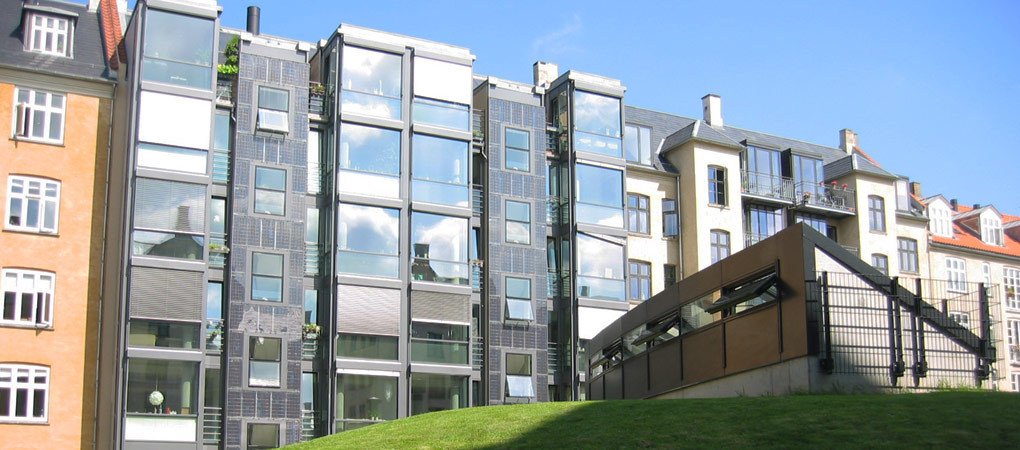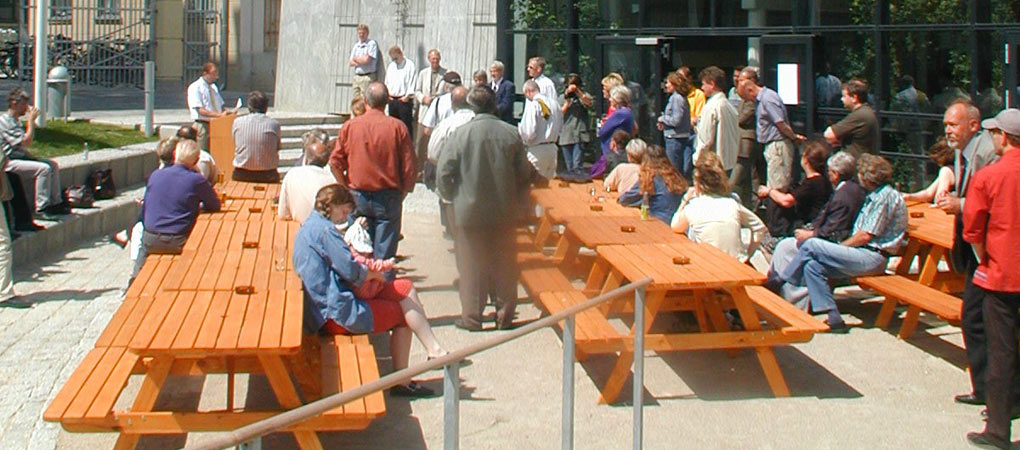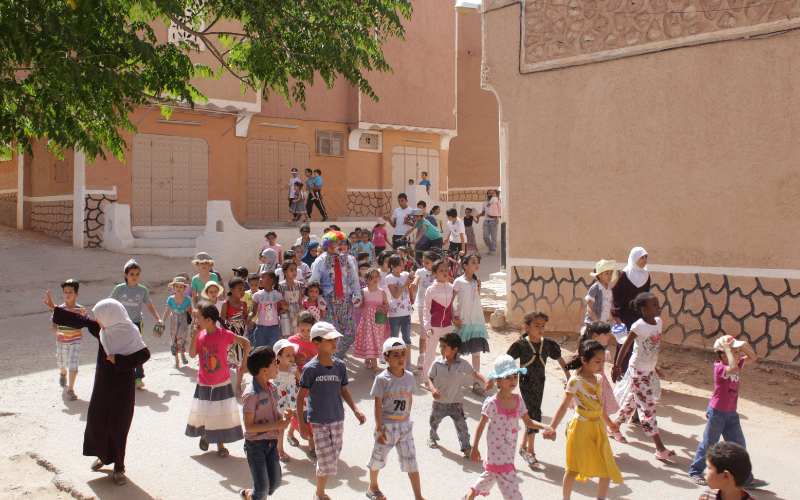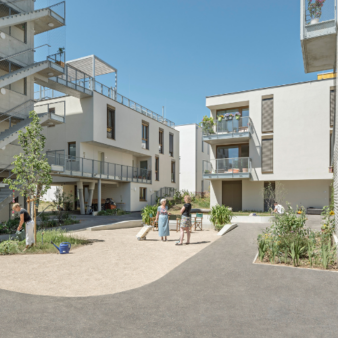Renewal of the dilapidated Hedebygade urban block in Copenhagen has provided an opportunity to demonstrate a range of innovative urban ecology solutions. Twelve different demonstration sub-projects have been established in this mixed tenure block of nineteen 5-storey apartment blocks. These sub-projects provide examples of how to improve environmental sustainability by means of waste management, use of solar energy, flexible facades and the use of green plants for air cleaning. Communal facilities and waste recycling systems have been provided for the residents of all 281 apartments and there is regular monitoring of the various systems introduced to assess their impact. To date energy savings of 20 per cent have been achieved compared to other renewal projects in the city and water consumption is also 20 per cent lower.
Project Description
Aims and Objectives
The project aims and objectives are:
- To establish a large demonstration project in Copenhagen to provide an example of environmentally sound urban renewal.
- To contribute to the further development of urban ecological solutions for the renovation of existing properties.
- To demonstrate the resources available in Denmark for such restoration.
- To contribute to the commercial use as well as to urban ecological renovation.
Renewal of the Hedebygade urban block is part of an on-going renewal of the Vesterbro area of Copenhagen. This is a central industrialised area of Copenhagen with a mix of buildings for trade, industry and residential purposes built in the late nineteenth century.
Prior to the urban renewal, the nineteen 5-storey blocks that comprised the total urban block were very dilapidated. Originally containing 500 flats, part of the urban block was demolished in the 1970s. After this there were 350 flats remaining, many of which were very small and without proper bathrooms.

All of the nineteen 5-storey blocks were restored as part of a conventional urban renewal scheme to current Danish building regulation standards. In addition, 12 demonstration sub-projects were carried out on the site to provide examples of additional ways of improving the environmental sustainability of urban restoration. Other projects such as waste sorting, provision of communal grounds and consumption monitoring were applied throughout the urban block. Similarly the provision of a new-build community facility in the courtyard, containing a community hall, café, kitchen and launderette, is for use by all the residents. It is designed to the highest environmental standards of recycled materials. The launderette permits recycling of rinse water and is supplemented by rainwater. The other sub-projects include various ways to use solar energy, the use of a prism to improve natural lighting, flexible facades, and the use of green plants to clean the air. There is a range of tenure arrangements, with eight blocks owned on a co-operative basis, one block of owner-occupiers, one block is privately rented and nine blocks are managed by the municipality.
The number of flats was reduced from 350 to 281 in order to make the average flat size larger. This was done to overcome the problems of frequent household movement and lack of social stability. There is now a much more stable population in the area as households are able to remain in their flat when their family size increases. All existing tenants were decanted while the work was carried out (for an average of 8-9 months) and were given the choice of moving back into the block or having another flat in the local area. The number of tenants choosing to move back to the block was higher than average in urban renewal programmes. Relatively few people chose to be re-housed outside the local area.
Construction took place from 1998 and the first projects were completed in 2000. The courtyard was the last element to be finished and this was in 2002. The projects are all being monitored and evaluated as part of the project.
A co-ordination group was formed of civil servants from the municipality and ministry, SBS, tenant advisors, the association of landlords and 4 tenant representatives. Project groups from each of the 12 sub-projects were formed from technicians (mainly engineers and architects) the tenants living in the relevant house and SBS. The tenant representatives were democratically chosen. The co-ordinating group’s role was to manage the day-to-day problems and decisions that arose in the implementation of the sub-project. Other groups established were for the owner-occupiers, a courtyard group and an ecology group. Three community workers were hired to provide information and support to the residents on the urban renewal process and the ecological developments in particular.
Total renewal costs for the entire block, including planning, renovation woks and the development of the courtyard were US$44.3 million, with a further US$6.8 million for the 12 sub-projects. The Municipality of Copenhagen and the former Ministry of Housing and Urban Affairs provide financing. The owners or landlords of the properties meet on-going running costs. The project is now complete and no further capital investment will be required. On-going maintenance costs will be met by the property owners (municipalities, cooperatives, owners etc.). Monitoring will continue to be funded by the municipality, together with promotional and educational work carried out regarding the project.
Why is it innovative?
- Use of an integrated approach to urban renewal.
- Innovation in design to maximise use of solar energy.
- Involvement of the local residents in the planning and decision making processes.
- Retention of a wide range of tenures within the block.
- Use of a comprehensive approach to ecological restoration to include waste sorting, green lifestyle, air cleaning with green plants.
What is the environmental impact?
Eco accounts have been kept and show a demand for heating reduced by 20-25 per cent compared to flats in traditional renewal (although consumption is still higher than predicted by the energy engineers) and 35-45 per cent compared to the dwellings before renewal. Water consumption is also 20 per cent lower. Recycled and locally sourced materials are used wherever possible.
There is a greater understanding of the environmental issues by the residents.
Is it financially sustainable?
Rents have increased as a result of the urban renewal programme, since it had the effect of increasing the size of some of the flats. There are statutory limits on the extent to which rents can be increased in any one year. The increase varies from US$42 to US$105 per m2 per year, spread over a 10-year period. Government support is available to those who cannot afford to meet their rental income costs. Owners have to contribute towards the cost of the improvements on their properties. The reduced fuel and water costs means that less household income has to be spent on these essential commodities.
What is the social impact?
There is a wide range of age, income, background/culture and vulnerability amongst those living in the project. Working together during the development of the project has helped to improve understanding and cooperation between the different groups.
Interest, competence and responsibility for living in a more sustainable fashion have increased throughout the 7 – 8 year development period of the project. An improved living environment has been achieved with a better indoor climate, leading to an improvement in residents’ health.
Evaluation
Careful monitoring of the building enables evaluation to take place. This is being carried out by the Danish Building and Urban Research Centre and the Danish Centre for Urban Ecology and shows significant reductions in electricity consumption (50 per cent reduction), CO2 emission (40 per cent reductions) and heat consumption (15 per cent reduction).
A much-improved living environment is provided for the residents as a result of the urban renewal programme, both in their individual apartments and also in the improved community life within the block and the provision of communal facilities. Although many residents were initially sceptical about the proposed work they are now enthusiastic about their new living environment.
The project has become a landmark – both for the residents and the adjacent blocks in the area. It has contributed to the branding of the area as a ‘Green Area’ and this has raised its status and profile.
Transfer
The technical innovations developed at Hedebygade have been used in other urban renewal projects in Denmark, including a much larger renovation project in another part of Copenhagen. Some of the individual sub-projects have been used in other projects in Fredericksberg and Copenhagen.
The project has been used to shape policy behind environmental standards needed for urban renewal in Denmark. The ideas are widely disseminated within Europe.
Partnership
NGO, local government, local community



